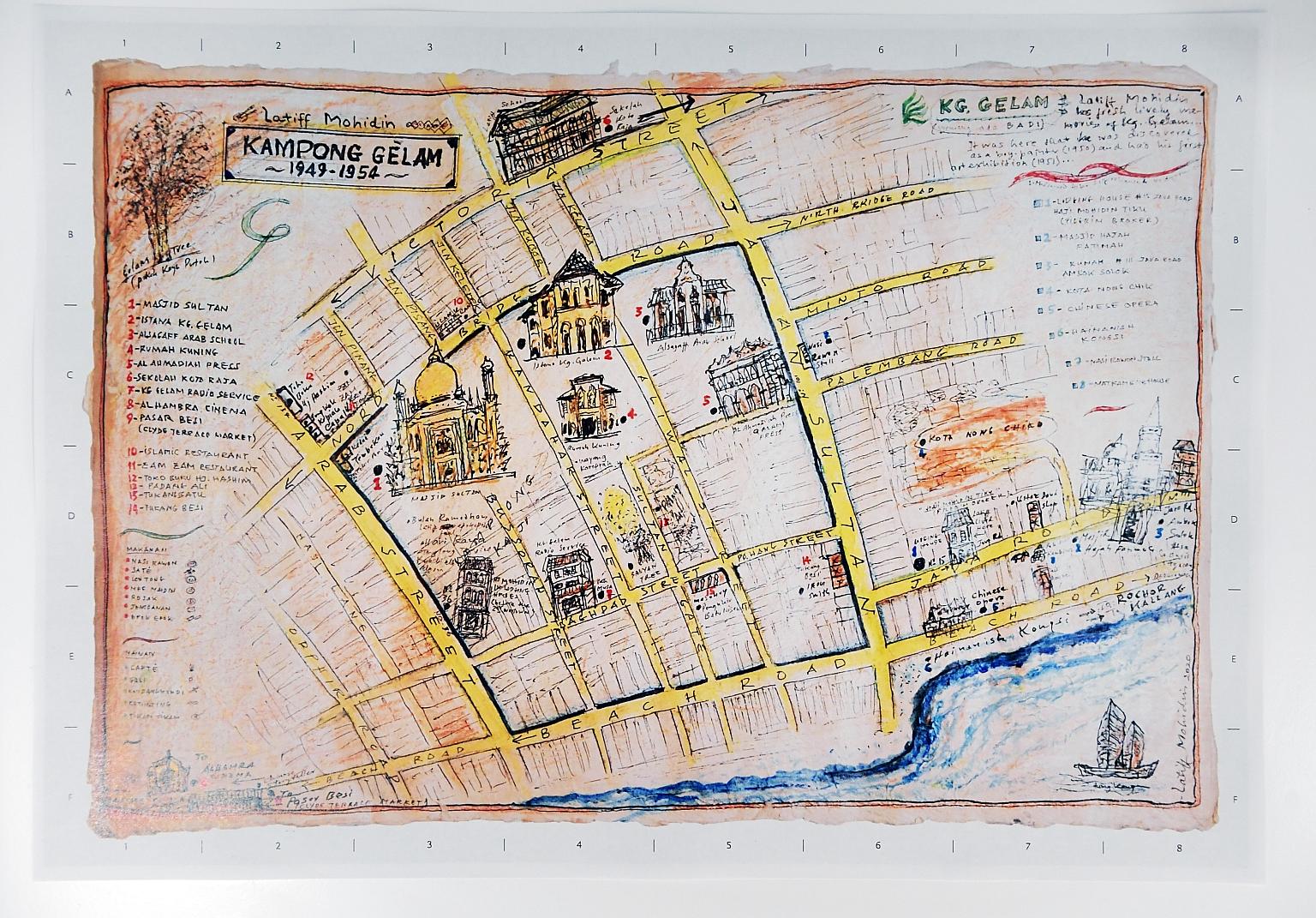Latiff Mohidin's Paris show comes to town
The exhibition at the National Gallery Singapore features a new section dedicated to the Malaysian artist's childhood here
Sign up now: Get ST's newsletters delivered to your inbox

This hand-drawn map of the Kampong Gelam neighbourhood, featured in Latiff Mohidin: Pago Pago, is a detailed depiction of the Malaysian artist's memories of the neighbourhood in Singapore where he grew up, complete with annotations for his favourite restaurants, such as Islamic and Zam Zam.
ST PHOTOS: ALPHONSUS CHERN
Follow topic:
One of the most endearing items on display at Latiff Mohidin: Pago Pago, which opens at the National Gallery Singapore on Friday, is a hand-drawn map of the Kampong Gelam neighbourhood.
It is a detailed depiction of the Malaysian artist's memories of the neighbourhood where he grew up during the 1950s, complete with annotations for his favourite restaurants, from a nasi rawon shop to outlets still extant today, such as the Islamic and Zam Zam restaurants.
The map, along with an entire section dedicated to the 78-year-old artist's childhood in Singapore, is new to the show, which the gallery co-curated with the Centre Pompidou in 2018.
It was the Parisian museum's first solo show dedicated to a South-east Asian artist. The Singapore show is on till Sept 27.
Dr Eugene Tan, director of the gallery, notes: "Latiff Mohidin is known as a Malaysian artist, but his work epitomises what modernism in South-east Asia is all about. We have expanded this exhibition to include very important and interesting aspects of his move to Singapore. This early part of his artistic development is very key."
Latiff came to Singapore from Negeri Sembilan, aged nine, with his mother to join his father. The latter ran a boarding house, catering to pilgrims on their haj journey, at 15 Java Road.
Senior curator Shabbir Hussain Mustafa, 35, who co-curated Pago Pago with Centre Pompidou's Ms Catherine David, says within months of Latiff's arrival, his teachers at Sekolah Kota Raja (Kota Raja school) recognised his talents.
The young boy became something of a "national project", says Mr Mustafa, as Latiff was mentored by local luminaries including writer Abdul Gani Hamid, founder of Angkatan Pelukis Aneka Daya (Artists of Various Resources), as well as pioneer Nanyang artist Liu Kang.
Both Malay-and Chineselanguage newspapers wrote stories about this child prodigy, who used to sell his paintings outside Raffles Hotel to tourists. Latiff's parents were not wealthy, but supported their son's artistic endeavours. In the attic of his father's boarding house, Latiff had a small studio where he worked.
Mr Mustafa adds that the sights and sounds of Kampong Glam inspired the artist: "Pak Latiff had this fantastic expression: he called it half craft, half art.
-
BOOK IT /LATIFF MOHIDIN: PAGO PAGO
WHERE: National Gallery Singapore, 1 St Andrew's Road
WHEN: Friday to Sept 27, Saturdays to Thursdays, 10am to 7pm, Fridays, 10am to 9pm
ADMISSION: Free for Singaporeans and permanent residents, $20 for non-Singaporeans
INFO: www.nationalgallery.sg
"This is how he remembers his childhood in Singapore. He would walk around the neighbourhood, observe people, scavenge objects and things to make art."
The children's activities for this show are inspired by these recollections.
Latiff, who is also a poet, was trained in Germany and travelled widely not just in the West, but also in South-east Asia.
His famous pagoda series, for which this exhibition was named, was an illustration of his crosscultural influences.
Pago Pago, Mr Mustafa explains, rose out of Latiff's wordplay on "pagoden", the German word for pagoda, and pagar pagar, an architectural feature of Minangkabau houses.
His mother is Minangkabau, a matrilineal society which also has the concept of "merantau", of leaving home to travel, which Latiff interprets differently.
Mr Mustafa adds: "He translates it as leaving the familiar behind."
The peripatetic artist certainly had more than his fair share of the unfamiliar, beginning with his move to Singapore as a child, arriving in Germany in 1961 on a scholarship in time to see the Berlin Wall going up and observing the post-colonial, Cold War upheaval in South-east Asia.
Mr Mustafa notes: "Pago Pago as a body of work comes together during the Vietnam War. The works are not about the war. The works are about an individual trying to make sense of this region."
Highlights of the Latiff Mohidin exhibition
READING THE QURAN (1959) AND JOGET (1960)
These works, part of the artist's personal collection, show how Latiff Mohidin drew inspiration from the everyday.
Reading The Quran (left) captures a scene from his childhood. Latiff's mother would take over the boarding house outside the haj peak season to teach the Quran to neighbourhood children as well as conduct sewing classes for women. Joget (right) similarly captures a familiar neighbourhood scene in 1960s Kampong Glam.
UNTITLED (NEO PAGO PAGO) (1971)
This acrylic on canvas was created for an exhibition at London's Commonwealth Institute. By 1969, Latiff felt that the Pago Pago series was becoming exhausted. But on an overland trip from Singapore to New York, via Bangkok and Kabul, he found new inspiration and created about 20 new images for the show. Unfortunately, after the show, most of the works were stolen. This is one of just two surviving pieces.
PAGODEN (1961)
This sketch is the genesis of the Pago Pago series. This was inspired after the artist visited the Ethnological Museum of Berlin, famed for its collection of non-Western arts and crafts. Latiff was fascinated by the museum's collection of Oceanic, Mayan and Asian artefacts.
STILL LIFES AND LANDSCAPES
Latiff won a scholarship from the German government to study in Berlin. Curator Shabbir Hussain Mustafa says Latiff joked that he was probably the only one to apply to the German embassy in Kuala Lumpur for the scholarship.
Berlin was a culture shock for the artist, who learnt the language by chatting with senior citizens in the park.
These are works he produced as a student at the Hochschule fur Bildende Kunste (Berlin University of the Arts).

